
|
Special Effects (F/X) - Milestones in Film 1950-1959 |
| Film Title/Year and Description of Visual-Special Effects | ||||||
 
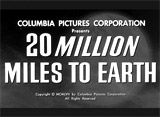 |
Films of Ray Harryhausen -
Special Effects Master and Model Animator Often partnered with Charles H. Schneer, his classic films with stop-motion animation and other special effects included:
|
  Jason and the Argonauts (1963) |
||||

|
Destination Moon (1950) This was Pal's second full-length live-action feature - about the first spaceship flight to the Moon. (In addition, Woody Woodpecker made an appearance to explain how rocket propulsion worked, using a shotgun.) Later Pal films included: The War of the Worlds (1953) and The Time Machine (1960), featuring time-lapse photography. |
  
|
||||
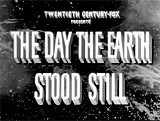
|
The Day the Earth Stood Still
(1951) It was also the first science-fiction film to feature "flying saucers" and the first true robot, Gort. |
 
|
||||

 
|
When Worlds Collide (1951)
This sci-fi disaster film was producer George Pal's follow-up film to Destination Moon (1950) - with a mediocre story that had spectacular special effects. Some of the best examples were a great fireball - a sun-sized body called Bellus - hurtling toward earth, and a rocket-propelled spaceship built on a ramp. |
 
|
||||

|
Bwana Devil (1952) Most of the action was filmed in Hollywood, but the background scenes were photographed, under director Arch Oboler’s direction, in the Belgian Congo and in British East Africa. The gimmicky 3-D effect required that the viewer wear special polarization glasses, unlike anaglyphic 3-D that required red/blue glasses to be worn. 3-D technology was employed to try to combat the encroaching competition of television on the film industry. The film featured man-eating Tsavo lions leaping toward the camera and flying spears thrown out of the screen. |

|
||||
This is Cinerama (1952) Paramount's wrap-around, big-screen Cinerama debuted in 1952. It was a break-through technique that required three cameras, three projectors, interlocking, semi-curved (at 146 degrees) screens, and four-track stereo sound. The first film using the three-strip cinerama process was This is Cinerama (1952), a travelogue of the world's vacation spots (e.g. Niagara Falls), with a thrilling roller-coaster ride at Rockaways' Playland. Although there were a few successful box-office Cinerama hits in the 1950s, the process was ultimately abandoned because its novelty wore off and the equipment and construction of special theatres was too cost-prohibitive and cumbersome. |
   |
|||||
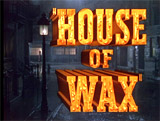
|
House of Wax (1953) Andre de Toth's horror film from Warner Bros. had the extra added attraction of being filmed in 3-D - and it was highly successful. It was the first 3-D color feature film released by a major American studio. It was a more expensive remake of their earlier Mystery of the Wax Museum (1933), with Vincent Price establishing himself forever after as the quintessential horror villain. Although this was a horror film, the most remembered 3-D scene in the film was the paddle-ball sequence in which a huckster (Reggie Rymal) in front of the newly-opened "House of Wax" kept swatting at a ball attached by a string to a paddle. He spoke at the theatre audience and noted:
|
 
|
||||
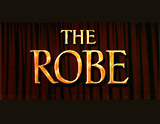
|
The Robe (1953) When Cinerama and stereoscopic 3-D died almost as soon as they were initiated, 20th Century Fox's CinemaScope became cheaper and more convenient because it used a simple anamorphic lens to create a widescreen effect. The aspect ratio (width to height) of CinemaScope was 2.35:1. The special lenses for the new process were based on a French system developed by optical designer Henri Chretian. The first film released commercially in CinemaScope was 20th Century Fox's and director Henry Koster's Biblical sword-and-sandal epic The Robe (1953). It debuted in New York at the Roxy Theater in September of 1953. Other milestones in widescreen formats included:
|
|
||||
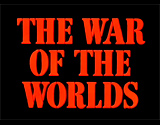  |
The War of the Worlds (1953) This was the first visual effects-laden "popcorn" film, featuring vibrant color special effects, and the partial destruction of various cities and landmarks, including the famous Los Angeles Courthouse Building, the Eiffel Tower in Paris, the Taj Mahal in India, etc.. [Note: This sci-fi film would inspire the creation of others, such as Independence Day (1996) and Steven Spielberg's remake War of the Worlds (2005).] |
  
|
||||

|
The Creature from the Black Lagoon (1954) This classic Universal horror film effectively used a foam-latex costume suit to represent the amphibious creature called the Gill-Man - one of the most famous movie monsters ever created. |
 
|
||||
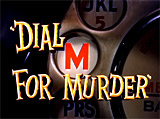
|
In Hitchcock's classic thriller, Tony Wendice (Ray Milland) blackmailed (or "influenced") Captain Lesgate/Swann (Anthony Dawson), a former classmate with a criminal record, to commit the "perfect murder" - the killing of his wealthy wife Margot Wendice (Grace Kelly) in order to inherit her fortune. She was involved in an affair with TV mystery writer Mark Halliday (Robert Cummings). During the attempted strangulation scene, the tension was ratcheted up. Tony's plan was to have his wife leave her bedroom to answer the living room phone, to enable Lesgate to strangle her from behind the window curtains where he was hiding. Tony dialed the number, but because his watch had unexpectedly stopped, he was about eight minutes too late. The assassin was frazzled and about to leave because of the delay. When the phone finally rang, the camera panned around Margot as she answered. The camera moved to view Swann's position behind the curtains. Reflections from the fireplace played upon the walls in the darkened room. He approached with a twisted scarf and wrapped it around her neck. But she foiled his strong attack. There was the tremendous 3-D effect of Margot reaching back behind her - into the audience from the screen - searching for a weapon (a pair of scissors) to defend herself and kill the assassin by stabbing him in the back. When he fell to the floor onto his back, the blades of the scissors were pushed more deeply into his body. |
  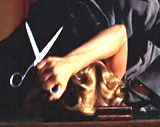
|
||||
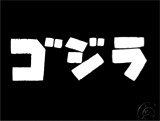
|
Gojira (1954, Jp.) (aka Godzilla, King of the Monsters (1956)) Although the special effects weren't exactly revolutionary, they were influential, nonetheless, in this story about a giant monster awakened, irradiated and mutated by atomic H-Bomb tests in the ocean. The effects were created by animatronic models, miniatures of the city of Tokyo, and by a man in a 6 and 1/2 foot lizard suit (framed with wires and bamboo sticks covered in latex). |

|
||||

|
20,000 Leagues Under the Sea (1954)
It was notable for its depiction of the Nautilus and the giant squid fight. The other nominated films in the category were:
|
 
|
||||

|
Conquest of Space (1955) This was FX artist George Pal's and director Byron Haskin's semi-documentary, visionary sci-fi story about a dangerous spaceship journey to the planet of Mars, following Pal's success with Destination Moon (1950), When Worlds Collide (1951), and The War of the Worlds (1953). The opening voice-over narration of this Paramount Technicolored film proclaimed: "This is a story of tomorrow, or the day after tomorrow...', and the film's tagline stated: "See How It Will Happen...In Your Lifetime." The film's science was based directly on rocket scientist Wernher von Braun's writings and designs in Collier's Magazine. Although a box-office flop with some hokey special effects, some of the more impressive ones including a modified V-2 rocket transporting astronauts into space, a circular spinning space station ("The Wheel"), interstellar vehicles, astronauts with full-pressured suits doing space walks, and the Martian landscape. [Note: Stanley Kubrick was strongly influenced by this
film, and based much of the design and plot elements of |
  
|
||||
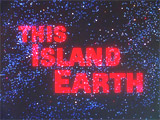
|
This Island Earth (1955) This cerebral 1950's science-fiction film by director Joseph M. Newman required various special effects, including:
Both were created with models and special camera techniques. It also necessitated alien makeup for the big-headed Metalunans, and futuristic set designs. |
 
|
||||
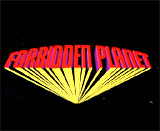
|
One of the landmark science-fiction films of the 50s was this classic space adventure film from director Fred Wilcox - an adaptation of Shakespeare's The Tempest. It was the first science-fiction film in color and CinemaScope. Its Oscar-nominated Special Effects included miniatures (e.g., the flying saucer spaceship), innovative set and art decoration (with cyclorama scenic matte paintings) to create the alien environment of Altair-IV. It also included the famed friendly servant prop (probably the most expensive, intricately-wired film prop ever constructed at the time (at $125,000)) -- Robby the Robot, also used as a prop in MGM's The Invisible Boy (1957) a year later. The film also featured an all-electronic music score. One of the best remembered segments was the 'animated' night attack (using hand-drawn cel animation) of the ID monster on the flying saucer spaceship - in actuality, it was displaying Dr. Morbius' (Walter Pidgeon as Prospero) face-to-face encounter with his own projected sub-conscious, incestuous feelings for his lovely young daughter Altaira (Anne Francis). |
  
|
||||

|
The Girl Can't Help It (1956) Director Frank Tashlin, a former cartoonist, created a satirical mid-50s film that was most memorable for the role played by buxom blonde bombshell Jayne Mansfield, with a shapely hourglass figure. However, it was also known for its unique opening or preamble, in which one of the film's stars, a bow-tied Tom Ewell, opened the film by walking out onto a open stage to speak to the camera (and break the fourth wall) and to introduce the feature. The background was an abstract landscape with musical instruments floating in space. Annoyed with the small sized B/W picture, he astonished audiences by literally stretching the black edges of the boxy black and white picture - opening the viewable picture up into the wider, rectangular Cinemascope aspect ratio. And then he commanded that the picture change from B/W to Technicolor - "gorgeous life-like color by DeLuxe." [Note: The same joke to open up the screen (for Odorama) was used in John Waters' Polyester (1981) - in homage to this film.] The film ended with a similar cartoonish bit by the other major male star Fats Murdock (Edmond O'Brien), who like the cartoon Porky Pig ("That's all folks!") stepped through the enclosing frame of the final shot, walked forward through the black, now-empty space to directly address the audience:
Then, he grabbed a cigar from somewhere, as the title song began to play. |
 
  
|
||||

|
The Ten
Commandments (1956) The scene (before the days of digital effects) was prefaced by Moses' (Charlton Heston) statement: "The Lord of Hosts will do battle for us. Behold his mighty hand." It involved the use of miniatures, pyrotechnics, traveling matte paintings, rear-projection, and a 32-foot high dam or water tank churning out the waterfall. The effect of the sea's parting was created by pouring 300,000 gallons of water into a tank and then playing the shot backward.
Other special effects scenes included the various plagues, and the Burning Bush. In the massive Exodus sequence, compositing was used to multiply the number of extras in the crowd. |
 The Burning Bush  Nile Turned Blood Red  The Parting of Red Sea |
||||

|
The 7th Voyage of Sinbad (1958) Director Nathan Juran's classic fantasy film (with stop-motion special effects by Ray Harryhausen) wasn't even a nominee in the awards category of Best Special Effects. It was the first film using stop-motion special effects to be shot in full color. In this year, the winner was George Pal's family-fantasy musical Tom Thumb (1958) (the famed producer's first directorial effort for a feature film). There was only one other competing Oscar nominee - director Joseph Pevney's submarine war drama Torpedo Run (1958). Amazing sequences (mostly on the monster-filled island of Colossa) included:
|
    
|
||||
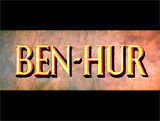
|
Director William Wyler's Ben-Hur won a record-breaking 11 Academy Awards, including Best Picture and Best Special Effects. It was filmed in Italy at Rome's Cinecitta Studios, and in other locales. The monumental film was photographed in the "new" MGM Camera 65 (65mm), MGM's single-strip answer to the widescreen craze of Cinerama, later known as Ultra Panavision 70. More than 300 sets were constructed over almost 150 acres, with the most elaborate one being the arena (the largest single movie set ever built) for the 9-minute chariot race sequence, with four 30-foot high statues in the center. The race segments took five weeks to film (extended over a three month period), with several thousand extras used for spectators. Another of the more spectacular sequences was the great naval battle, pitting a Roman galley against its enemy. It was filmed using 40 miniatures in a huge tank on the back lot at MGM Studios in Culver City, California, and there were also two life-sized Roman galleys built for the production that were combined with the miniatures by process shots and traveling mattes. |
   
|
||||

|
Journey to the Center of the Earth (1959) Based on Jules Verne's 1864 science-fiction novel, this Henry Levin-directed fun adventure-fantasy film had fake looking (and now dated) special effects, although they were still effective. It was remade as Journey to the Center of the Earth (1993), starring Brendan Fraser. It was a tale of explorers entering an Icelandic volcano, and finding themselves at the 'center of the earth' - the earth's core. There they encountered:
The 'dinosaurs' were nothing more than gigantic reptiles. Some of the underground sequences for the film were at Carlsbad Caverns National Park, and other exotic locales, although nowadays, matte paintings and other CGI enhancements would have substituted. |
   Dimetrodon  Lost City  Giant Chameleon |
||||

|
Darby O'Gill and the Little People (1959) In-camera effects in this live-action fantasy, a Walt Disney production directed by Robert Stevenson, included the 'trick' of forced perspective depth effects. This was at a time in cinematic history when Disney Studios maintained its own in-house special effects department. Full-sized Darby O'Gill (Albert Sharpe) appeared to be walking and conversing with live leprechauns (two feet high), although in actuality, it was a magical movie-camera trick. Darby was positioned closer to the camera in the foreground, to make him appear larger, while the 'little people' were placed at a distance in relation to him, to appear smaller. This special-effects technique required an increased depth of field, and intense lighting to be effective. The effect eliminated post-production optical patching, and grainy images and matte lines were not evident as well. The most spectacular scene was one in which hundreds of leprechauns danced and raced on white ponies around Darby. Also notable were the scenes of the banshee (a ghostly luminous figure) and the death coach with the headless horseman. The same perspective depth technique was used in The Never Ending Story (1984) in the scene of young Atreyu (Noah Hathaway) with two gnome characters (Sydney Bromley as Engywook, and Patricia Hayes as wife Urgl). |
   
|
||||